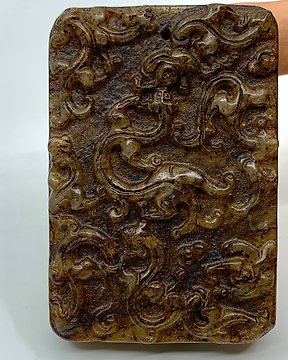
Starożytne Chiny, Dynastia Han jadeit Zawieszka z jadeitu (zawieszka z rdzawego jadeitu) - 1.3×5×7 cm
Nr 83106635

Nr 83106635

"The Pelican" is a type of seabird that has a large pouch under its beak that it uses to scoop up fish from the water. The pelican was a sacred animal for the Chancay people, as it represented abundance, fertility, and power. The pelican was associated with the sea god Ni, who was also known as Kon or Illapa. Ni was the creator of life and the ruler of the weathe
In terms of symbolism, the pelican's association with fishing and abundance could have made it a symbol of prosperity, sustenance, and fertility. It is possible that pelicans where depicted in art and iconography to represent these ideas, or they may have been featured as part of myths and narratives that conveyed important cultural and spiritual messages.
Feather work was a specialised craft that involved the use of various bird feathers to create exquisite textiles, garments, headdresses, and other decorative objects.
Skilled artisans meticulously collected, cleaned, and sorted feathers according to their colours and sizes. They then used various techniques to create intricate patterns and designs. Some common techniques included feather-piercing, where feathers were punctured and tied together to form a fabric-like surface, and feather mosaic, where small pieces of feathers were arranged to create detailed images.
Feather works served several purposes within pre-Columbian Peruvian societies. They were often used as ceremonial garments for high-ranking individuals, including priests, rulers, and warriors. These garments were symbols of status, power, and religious significance.
In addition to their use in clothing and accessories, feather works adorned architectural structures, including temples and palaces. Feathered tapestries and banners were hung as decorative elements, further showcasing the craftsmanship and artistic skills of the ancient Peruvian cultures.
The production of feather works required extensive knowledge of local bird species, their habitats, and their behaviours. Feathers were typically obtained through trade networks, as certain bird species were not native to all regions of ancient Peru. This trade in feathers helped foster connections between different cultures and regions.
Non-CITES Species Inspection Doc # ESAG5000523W: "Cairina moschata domestica " , commonly known as
Barbary ducks were domesticated by Native Americans since Pre-Columbian times.
The black and white feathers are difficult to identify, for the obvious reason that many birds have such plumage and, in addition, feather workers sometimes trimmed the feathers to refine the design, thus destroying the distinctive silhouette.The white plumage used by the Chimú, Chancay and Nazca cultures was made mainly from the feathers of seabirds, These birds are known for having white feathers on their bodies.
As for yellow or orange dyed feathers, the Chimú, Chancay and Nazca cultures used different sources to obtain the desired colours. Among the possible species used to dye feathers yellow are the achiote plant (Bixa orellana) and the palillo (Curcuma longa). These plants are known to produce yellow pigments used in textile dyeing.
To obtain orange-coloured feathers, the cultures mentioned may have used other natural sources, such as annatto in combination with other dyes or colour-mixing techniques.
Family Heirloom Private Collection Ex. Dr Rivadeneyra collection, Berlin late 1960s to early 1970s. To present owner by descent.Collected through the years by my father Dr. Jose Rivadeneyra Leon and by my grandfather Engr. Julio Rivadeneyra who lived in northern Peru central coast near Chiclayo.
Privately purchased and/or gifted by family members who loved collecting like his cousin,
Carlos Williams Leon who was a Peruvian renowned architect and archeologist. https://es.wikipedia.org/wiki/Carlos_Williams_Le%C3%B3n
Most of the collection was taken to Berlin in 1969 when my father was doing medical research there
Artwork with well-documented legal provenance and Spanish Historical Patrimony Export Certificate.
Any other costs or charges such as customs or import duties, customs clearance and handling may also apply during the shipment of your lot and will be charged to you by the involved party at a later stage if applicable.
The seller will provide all provenance information about the object to the buyer. The seller ensures that any necessary permits are/will be arranged. The seller will inform the buyer immediately about any delays in obtaining such permits.
If the piece goes outside the European Union a new export license will be requested by us, this process can take between 1 and 2 months. According to Spanish legislation, items sent outside the European Union are subject to export taxes and will be added to the invoice, at the buyer's expense. These export fees are fixed on the final auction price and the tax rate is not applied directly on the total value of the item to be exported, rather the different percentages by sections are applied to it:
- Up to 6,000 euros: 5%..- Shipped with Insurance.
Item legal to buy/sell under U.S. Statute covering cultural patrimony Code 2600, CHAPTER 14
This object is subject to the UNESCO Cultural Heritage Protection Act. For shipment to a non-EU member state, export regulations will vary.
Jak kupować w serwisie Catawiki
1. Odkryj coś wyjątkowego
2. Złóż najwyższą ofertę
3. Dokonaj bezpiecznej płatności